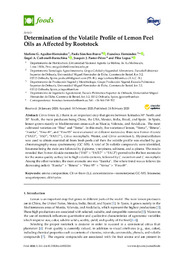Resumen :
Citrus limon (L.) Burm is an important crop that grows between latitudes 30◦ North and
30◦ South, the main producers being China, the USA, Mexico, India, Brazil, and Spain. In Spain,
lemon grows mainly in Mediterranean areas such as Murcia, Valencia, and Andalucía. The most
cultivated varieties are “Fino” and “Verna”. In this study, five varieties of lemon, “Verna”, “Bétera”,
“Eureka”, “Fino 49”, and “Fino 95” were evaluated on different rootstocks: three new Forner-Alcaide
(“FA13”, “FA5”, “FA517”), Citrus macrophylla, Wester, and Citrus aurantium L. Hydrodistillation
was used to obtain essential oil from fresh peels and then the volatile profile was studied by gas
chromatography-mass spectrometry (GC-MS). A total of 26 volatile compounds were identified,
limonene being the main one followed by β-pinene, γ-terpinene, sabinene, and α-pinene. The results
revealed that Forner-Alcaide rootstocks (“FA5” > “FA517” > “FA13”) proved to be the best rootstocks
for the aroma quality as they led to high volatile contents, followed by C. aurantium and C. macrophylla.
Among the other varieties, the most aromatic one was “Eureka”. The whole trend was as follows (in
decreasing order): “Eureka” > “Bétera” > “Fino 95” > “Verna” > “Fino 49”.
|
 La licencia se describe como: Atribución-NonComercial-NoDerivada 4.0 Internacional.
La licencia se describe como: Atribución-NonComercial-NoDerivada 4.0 Internacional.
.png)
